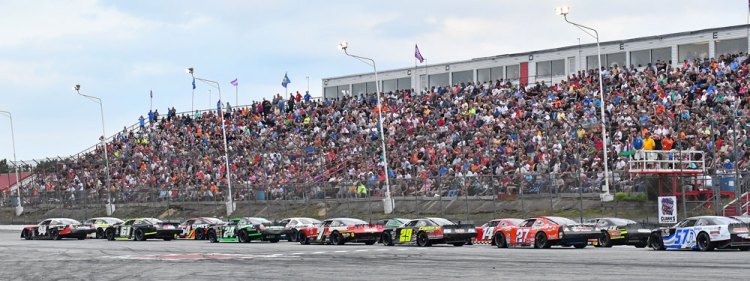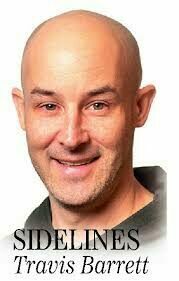OXFORD — The days of 100 cars showing up to try and qualify for the Oxford 250 are long gone. The funny part about that is that nobody seems to care much.
A decade ago, it was all anybody cared about, so much so that in 2006 Bill Ryan Jr. decided to drastically alter the landscape of the race at his Oxford Plains Speedway so that he wouldn’t be viewed as the guy who watched the Oxford 250 die on his watch.
These days, current speedway owner Tom Mayberry begins each Oxford 250 media day with an update on the entry list and the number of cars expected to compete for the $25,000 first prize each Sunday. On Wednesday this week, Mayberry threw out the number 57 for Sunday’s 46th annual Oxford 250 and people hardly blinked.
Nobody gasped. Nobody rolled their eyes. Nobody wrote an angry blog entry about the good ol’ days being gone. Nobody keeled over and died on the spot.
Racing has changed since six-time Pro All Stars Series champion Johnny Clark debuted as a rookie in the Oxford 250. A total of 109 cars attempted to qualify for that race in 1997. In most years during the 1990s, the race drew between 80 and 100 entrants.
“If it ever dropped off below 50 (entries), I’d probably be disappointed,” Mayberry said. “The days of 100 cars showing up, when that was happening look at all the tracks that were running these cars. You look now, you still have a pretty good pool to draw from, but you don’t have the Connecticut tracks running them weekly and some other places, too. Some that have them only have 10 or 12 a week.
“But if you look at the amount of these cars that are out there, and you compared now to then, I bet we’re still at a pretty good ratio.”
I’ll be honest, I’ve always thought of Oxford 250 qualifying as overrated. Over the last decade, there have been very few drivers who failed to qualify that shocked you. Give me 60 cars this Sunday, and I can easily predict for you 12 that won’t make the starting 40-car field.
In the days of 100 cars, there were maybe 12-15 who had a legitimate shot to win. This year, two-time Oxford 250 champion Ben Rowe believes that number is as high as 30.
“It blows everybody’s mind, but you’ve got to have an affiliate. That’s basically what it boils down to,” Rowe said this week. “If you’ve got a Howe car, you’re with Jeff Taylor. If you’ve got a Port City car, you’re tied in with Shane Tesch or Gary Crooks. We bought a Senneker car, so we’re with Mike Garvey. There’s 25 cars out there tied in with (shock specialist) Seth Holbrook. Dale Shaw’s cars, they all go to Dale. You’ve got to have that information.
“That’s what you see now — you’re paying for the information these people learn, and it’s hard to get on your own.”
Fewer cars to draw from. More teams with the same information available to them. And there’s another thing, Rowe believes, that also has changed the game considerably.
Technology. As in, too much of it. It’s led to less horsepower and the cars doing all the work.
“I say it’s go-kart racing now,” Rowe said. “The kids coming up through the go-kart ranks where everything is tied down, bound down, big momentum. That’s where this has kind of gone. These cars are just big go-karts now. There’s no spring, it’s all torsion. … That’s where it’s gone and basically where racing’s headed.”
Spoiler alert, for anybody who believes a bread-and-butter Super Late Model driver like Rowe — who has more PASS wins than anybody in history — could find the positives in the vision the late Tom Curley shared for his Late Model tour. He thinks the American-Canadian Tour was on to something.
“A certain guy that started his own tour years ago saw this with no bump stops and just springs. You’d see it racing Saturday nights here with those type of cars,” Rowe said. “These (Super Late Models) have gotten way out of hand. It’s crazy.
“Back in the day, you’d see me or my dad (Mike Rowe) get up on the wheel and you could carry a car. I don’t think you can see that anymore. The more you try to drive a car and the harder you try to go, the worse it goes. The last race here, I was so mad I was swearing up a storm and sliding all over the place. but once you settle down and just drive the race car, it starts going forward.
“I’d rather have it where the driver makes more of a difference.”
Other teams and drivers seem not to care quite as much — if they’ve got access to the information everyone else has, then they’ve got the same shot to win the Oxford 250 as anybody else.
At least that’s the theory, and it’s one Mayberry believes is working right now. Only two races in America, according to statistics on the short track racing website Speed 51 last December, had more cars entered than the Oxford 250 in 2018.
Both of those races were races in the southeastern part of the country for NASCAR-sanctioned Late Models.
“I’m more impressed with the quality of the field,” Mayberry said. “One of the things I’m proud of is that we’ve built this into the big short track race for the short-trackers. We don’t pay a (NASCAR Cup Series) guy to come in and try to win the money. These guys support it and do this kind of racing all year long.
“I think the fans have really, really adapted to that. I think it’s one of the things we’ve done that make it kind of special and unique to the fans. I think the quality there is what I’m happy about.”
Quality over quantity. Count me in.
As long as that’s the only thing you’re counting this weekend.
Send questions/comments to the editors.






Success. Please wait for the page to reload. If the page does not reload within 5 seconds, please refresh the page.
Enter your email and password to access comments.
Hi, to comment on stories you must . This profile is in addition to your subscription and website login.
Already have a commenting profile? .
Invalid username/password.
Please check your email to confirm and complete your registration.
Only subscribers are eligible to post comments. Please subscribe or login first for digital access. Here’s why.
Use the form below to reset your password. When you've submitted your account email, we will send an email with a reset code.